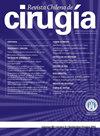Evaluación comparativa de efectividad y tolerabilidad con polietilenglicol y picosulfato de sodio-citrato de magnesio como agentes de preparación intestinal para colonoscopia
Q4 Medicine
引用次数: 1
Abstract
Introduction: The effectiveness of colonoscopy depends on multiple factors, being two of the most important ones an adequate bowel preparation and the patient’s tolerability to the preparation. Objectives: Compare effectiveness and tolerability of two bowel preparation agents, polyethylene glycol (PEG) and sodium picosulfate/magnesium citrate (SPMC). Patients and Methods: Randomized clinical trial on outpatients that went into colonoscopy in INDISA Clinic. We evaluated effectiveness and tolerability with Boston Bowel Preparation Score (BBPS) and Lawrence questionnaire [composed by Likert scale, two qualitative questions and Visual Analogue Scale (VAS) for pain], respectively. Results: 189 patients, 123 were randomized to PEG and 66 to SPMC. BBPS average in patients in the PEG branch was 7.51 (SD 1.66) and for SPMC 7.12 (SD 1.71) (p = 0.111). Likert scale for evaluating tolerability average for PEG was 0.94 (SD 0.68) and for SPMC 0.63 (SD 0.61) (p = 0.0004). VAS scale for PEG had an average of 7.68 (SD 2.4) and for PSCM 9.04 (SD 1.59) (p < 0.0001). When we asked for workplace absenteeism, there were no significant differences between both groups and when we asked about using the same intestinal preparation in a future colonoscopy there was statistical significance in favor to SPMC (p = 0.026). Conclusions: No differences were noted on effectiveness between the PEG and SPMC bowel preparations. Nevertheless, SPMC appeared to be better tolerated by patients.聚乙二醇和皮硫酸钠柠檬酸镁作为结肠镜检查肠道制剂的有效性和耐受性的比较评价
结肠镜检查的有效性取决于多种因素,其中最重要的两个因素是充分的肠道准备和患者对准备的耐受性。目的:比较聚乙二醇(PEG)和皮硫酸钠/柠檬酸镁(SPMC)两种肠道制剂的疗效和耐受性。患者和方法:随机临床试验的门诊患者进入结肠镜检查INDISA诊所。我们分别用波士顿肠准备评分(BBPS)和劳伦斯问卷(由李克特量表、两个定性问题和视觉模拟疼痛量表(VAS)组成)评估有效性和耐受性。结果:189例患者,123例随机分为PEG组,66例随机分为SPMC组。PEG分支患者的平均BBPS为7.51 (SD 1.66), SPMC患者的平均BBPS为7.12 (SD 1.71) (p = 0.111)。评价PEG耐受性的李克特量表平均为0.94 (SD 0.68), SPMC耐受性的李克特量表平均为0.63 (SD 0.61) (p = 0.0004)。PEG的VAS评分平均为7.68 (SD 2.4), PSCM的VAS评分平均为9.04 (SD 1.59) (p < 0.0001)。当我们询问工作场所缺勤情况时,两组之间没有显著差异,当我们询问在未来结肠镜检查中使用相同的肠道准备时,SPMC有统计学意义(p = 0.026)。结论:聚乙二醇和SPMC肠道制剂的有效性无显著差异。然而,患者对SPMC的耐受性似乎更好。
本文章由计算机程序翻译,如有差异,请以英文原文为准。
求助全文
约1分钟内获得全文
求助全文
来源期刊

Revista Chilena De Cirugia
Medicine-Surgery
CiteScore
0.20
自引率
0.00%
发文量
0
审稿时长
6-12 weeks
期刊介绍:
La Revista Chilena de Cirugía es un órgano de difusión del conocimiento y actividad quirúrgica. Su población objetivo son cirujanos, especialistas de otras áreas médicas, médicos generales y alumnos del área de la salud.
Sirve a cirujanos y otros especialistas, para publicar artículos originales e inéditos sobre temas médicos, en particular artículos de investigación básica y clínica, artículos de revisión, entre otros.
Buscan difundir y actualizar el conocimiento médico general y quirúrgico en particular. Se publica en forma bimestral.
La Revista Chilena de Cirugía está afiliada y patrocinada por la Sociedad de Cirujanos de Chilese desde el año 1952.
 求助内容:
求助内容: 应助结果提醒方式:
应助结果提醒方式:


